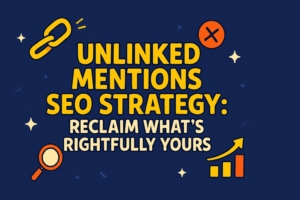
How To Create A Link To A Website? Let’s dive into it. A link is an incoming link from another website to your website. In other words, when someone links to one of your blog posts or articles from their site, that’s a link. Creating links is integral to any SEO strategy because they help your site become more visible to search engines. Search engines like websites with many high-quality links because it signals that the site is popular and trustworthy.
The process of creating a link is simple. Finding websites in your industry or niche interested in linking to your content would be best. Then, you reach out to the site owner or webmaster and let them know about your article or post. If they like what they see, they’ll add a link to your content on their site.
You can create a link to a website by using the HTML code <a> and the website’s URL. The <a> tag defines a hyperlink, which is used to link from one page to another. The href attribute specifies the URL of the page the link goes to.
When a browser displays a page, it checks for links to other pages using the URL. If it finds a match, it will display the linked page. If not, it will return an error message. For this reason, it’s essential to ensure you use the correct URL when creating links.
Why Create Links?
There are two main reasons why you should create links:
1. To improve your SEO
2. To drive traffic to your website
Let’s take a closer look at each of these benefits:
Improve Your SEO
As we mentioned earlier, links are one of the key ranking factors that search engines use to determine the quality and popularity of a website. So, if you want your website to rank higher in search engine results pages (SERPs), you must ensure you have plenty of high-quality links pointing to your site. Creating links can help you achieve this goal because the more links you have pointing to your site, the more popular it will appear to search engines.
Drive Traffic To Your Website
Links can also help drive traffic to your website by giving people more ways to find it. For example, let’s say you wrote a blog post about the ten best dog foods on the market today. If someone reads your blog post and likes it, they might share it with their followers on Twitter or Facebook. And if one of those people happens to have a popular blog or website in the pet industry, there’s a good chance they might link to your blog post on their site. This would give their readers another way to find your blog post—and, ultimately, your website—which could lead to more traffic.
Creating links is an integral part of any SEO strategy because they help improve your visibility and authority online, which can lead to more traffic for your website. Creating a link is simple: find websites in your industry or niche interested in linking to your content and reach out to them, letting them know about your article or post. If they like what they see, they’ll add a link!
How To Create A Link To A Website Via HTML Code?
The HTML code for creating a link is straightforward. First, add an opening <a> tag and specify the href attribute. This is followed by the text that will be displayed as a link. Finally, you need to add a closing </a> tag.
Here is an example of how the code would look:
<a href="https://www.example.com">This is a link</a> In this example, “https://www.example.com” is the URL of the page you are linking to, and “This is a link” is the text displayed as a link.
You can also use images as links. It would be best if you used the <img> tag instead of the <a> tag. The <img> tag allows you to insert images into your web pages. Here is an example of how this would look:
<a href="https://www.example.com"><img src="https://www.example-image .jpg"></a> In this example, “https://www .example-image .jpg” is the URL of the image you want to use as a link, and “https://www .example .com” is the URL of the page that you are linking to.
The Future Of Links In Web 3.0
With the rise of Web 3.0, the way we use links is changing. No longer are links simply a means of navigation between pages – they are now a vital part of the semantic web and are used to connect data and ideas. This has profound implications for SEO, and in this blog post, we’ll explore how links are being used in Web 3.0 and what this means for the future of search engine optimization.
Introducing The Semantic Web
The Semantic Web is a project started by Tim Berners-Lee the World Wide Web inventor. It aims to make data on the web more machine-readable so that computers can better understand it. This is done by adding ‘metadata’ to web pages, which gives information about the page content. For example, a page about a product might have metadata that includes the product name, price, and availability.
How The Semantic Web Is Changing Links
In the past, links were used primarily for navigation, allowing users to move from one page to another. However, with the advent of the Semantic Web, links are now also being used to connect data and ideas. This is done using ‘triples,’ which comprise a subject, predicate, and object.
For example, let’s say you have a page about coffee on your website. You could use a triple to say that ‘coffee is a type of drink.’ The subject would be ‘coffee,’ the predicate would be ‘is a type of,’ and the object would be ‘drink.’ Computers can then read these triples, which helps them understand the meaning of web pages.
What Does This Mean For SEO?
The introduction of triples presents several opportunities for SEOs.
- Firstly, we can optimize our pages for specific concepts rather than just keywords. This is because computers can now understand the relationships between different ideas so that we can target our content at particular concepts rather than just individual keywords.
- Secondly, it allows us to increase the number of links pointing to our pages. In the past, most links were generated through navigation – people would link to our pages when they wanted to link them from their site. However, now that links can be used to connect data and ideas, there are many more opportunities for generating links. For example, write an article about coffee that uses triples to connect coffee with other concepts (such as ‘drinks,’ ‘caffeine,’ or ‘breakfast’). Other websites that want to link to resources about those concepts will be more likely to link to your page.
The introduction of triples into linking represents a fundamental shift in how links are used on the web. This has enormous implications for SEOs, who now have an opportunity to optimize their pages for specific concepts rather than just keywords.” Links are no longer simply a means of navigation between pages – they are now a vital part of the semantic web.” If you want to stay ahead of the curve in SEO, you need to start thinking about how to use this new technology to your advantage.”
“The possibilities opened up by triples represent a huge opportunity for SEOs.” If you want to stay ahead of the curve in SEO, you need to start thinking about how to use this new technology to your advantage.”
Conclusion
Create a link to a website is a straightforward process that anyone with basic HTML knowledge can accomplish. All you need to do is use the <a> tag and specify the href attribute and the URL of the page you want to link to. You can also use images as links using the <img> tag instead of the <a> tag. Always use valid URLs when creating links so people can access the pages you’re linking to!


